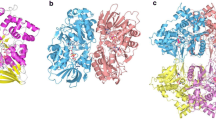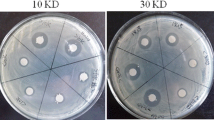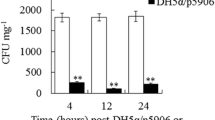Abstract
Fish produce mucus substances as a defensive outer barrier against several bacterial infections. We have recently identified an antibacterial l-amino acid oxidase (psLAAO1) in the mucus layer of the flounder Platichthys stellate. In this study, the antibacterial protein psLAAO1 was expressed as a secretory bioactive recombinant protein in the methylotrophic yeast Pichia pastoris. The recombinant psLAAO1 inhibited the growth of bacteria to the same levels as native psLAAO1 present in mucus. In particular, Staphylococci and Yersinia were strongly suppressed, showing the highest growth retardation of the 21 species and strains tested. Moreover, Staphylococcus epidermidis was most sensitive to psLAAO1 with a minimum inhibitory concentration (MIC) of 0.078 μg/mL, whereas Escherichia coli was essentially resistant to psLAAO1 with a MIC of >10 μg/mL. Interestingly, psLAAO1-treated E. coli were found to upregulate the expression of the btuE gene, which encodes glutathione peroxidase (GPx). The biochemical function of GPx is to reduce free hydrogen peroxide and is induced under response to reactive oxygen species (ROS). Thus, E. coli confers resistance to the reduced free hydrogen peroxide produced by psLAAO1 by increasing GPx levels. Furthermore, the growth of Staphylococcus aureus was completely inhibited in the presence of recombinant psLAAO1. The morphology of psLAAO1-treated S. aureus showed cell surface damage, the formation of large aggregates and the cells showed severe deformations. Western blot analysis showed that psLAAO1 binds to the surface of S. aureus. Therefore, psLAAO1 binds to the surface of LAAO-sensitive S. aureus and directs peroxidative activity at the surface of the bacterial membrane.






Similar content being viewed by others
References
Arenas FA, Díaz WA, Leal CA, Pérez-Donoso JM, Imlay JA, Vásquez CC (2010) The Escherichia coli btuE gene, encodes a glutathione peroxidase that is induced under oxidative stress conditions. Biochem Biophys Res Commun 398(4):690–694. doi:10.1016/j.bbrc.2010.07.002
Arenas FA, Covarrubias PC, Sandoval JM, Pérez-Donoso JM, Imlay JA, Vásquez CC (2011) The Escherichia coli BtuE protein functions as a resistance determinant against reactive oxygen species. PLoS One 6(1):e15979. doi:10.1371/journal.pone.0015979
Aslund F, Zheng M, Beckwith J, Storz G (1999) Regulation of the OxyR transcription factor by hydrogen peroxide and the cellular thiol-disulfide status. Proc Natl Acad Sci U S A 96(11):6161–6165
Butzke D, Machuy N, Thiede B, Hurwitz R, Goedert S, Rudel T (2004) Hydrogen peroxide produced by Aplysia ink toxin kills tumor cells independent of apoptosis via peroxiredoxin I sensitive pathways. Cell Death Differ 11(6):608–617
Cha MK, Kim WC, Lim CJ, Kim K, Kim IH (2004) Escherichia coli periplasmic thiol peroxidase acts as lipid hydroperoxide peroxidase and the principal antioxidative function during anaerobic growth. J Biol Chem 279(10):8769–8778
Chiang SM, Schellhorn HE (2012) Regulators of oxidative stress response genes in Escherichia coli and their functional conservation in bacteria. Arch Biochem Biophys 525(2):161–169. doi:10.1016/j.abb.2012.02.007
Clifford DP, Repine JE (1982) Hydrogen peroxide mediated killing of bacteria. Mol Cell Biochem 49(3):143–149
de Melo Alves Paiva R, de Freitas Figueiredo R, Antonucci GA, Paiva HH, de Lourdes Pires Bianchi M, Rodrigues KC, Lucarini R, Caetano RC, Linhari Rodrigues Pietro RC, Gomes Martins CH, de Albuquerque S, Sampaio SV (2011) Cell cycle arrest evidence, parasiticidal and bactericidal properties induced by l-amino acid oxidase from Bothrops atrox snake venom. Biochimie 93(5):941–947. doi:10.1016/j.biochi.2011.01.009
Ehara T, Kitajima S, Kanzawa N, Tamiya T, Tsuchiya T (2002) Antimicrobial action of achacin is mediated by l-amino acid oxidase activity. FEBS Lett 531(3):509–512
Gort AS, Ferber DM, Imlay JA (1999) The regulation and role of the periplasmic copper, zinc superoxide dismutase of Escherichia coli. Mol Microbiol 32(1):179–191
Hanane-Fadila ZM, Fatima LD (2014) Purification, characterization and antibacterial activity of l-amino acid oxidase from Cerastes cerastes. J Biochem Mol Toxicol 28(8):347–354. doi:10.1002/jbt.21571
Imlay JA (2003) Pathways of oxidative damage. Annu Rev Microbiol 57:395–418
Izidoro LF, Sobrinho JC, Mendes MM, Costa TR, Grabner AN, Rodrigues VM, da Silva SL, Zanchi FB, Zuliani JP, Fernandes CF, Calderon LA, Stábeli RG, Soares AM (2014) Snake venom l-amino acid oxidases: trends in pharmacology and biochemistry. Biomed Res Int 2014:196754. doi:10.1155/2014/196754
Kanazawa N, Shintani S, Ohta K, Kitajima S, Ehara T, Kobayashi H, Kizaki H, Tsuchiya T (2004) Achacin induces cell death in HeLa cells through two different mechanisms. Arch Biochem Biophys 422(1):103–109
Kasai K, Ishikawa T, Komata T, Fukuchi K, Chiba M, Nozaka H, Nakamura T, Sato T, Miura T (2010) Novel l-amino acid oxidase with antibacterial activity against methicillin-resistant Staphylococcus aureus isolated from epidermal mucus of the flounder Platichthys stellatus. FEBS J 277(2):453–465. doi:10.1111/j.1742-4658.2009.07497.x
Kitani Y, Tsukamoto C, Zhang G, Nagai H, Ishida M, Ishizaki S, Shimakura K, Shiomi K, Nagashima Y (2007) Identification of an antibacterial protein as l-amino acid oxidase in the skin mucus of rockfish Sebastes schlegeli. FEBS J 274(1):125–136
Kitani Y, Kikuchi N, Zhang G, Ishizaki S, Shimakura K, Shiomi K, Nagashima Y (2008) Antibacterial action of l-amino acid oxidase from the skin mucus of rockfish Sebastes schlegelii. Comp Biochem Physiol B Biochem Mol Biol 149(2):394–400
Laemmli UK (1970) Cleavage of structural proteins during the assembly of the head of bacteriophage T4. Nature 227(5259):680–685
Lee ML, Tan NH, Fung SY, Sekaran SD (2011) Antibacterial action of a heat-stable form of l-amino acid oxidase isolated from king cobra (Ophiophagus Hannah) venom. Comp Biochem Physiol C Toxicol Pharmacol 153(2):237–242. doi:10.1016/j.cbpc.2010.11.001
Lee ML, Fung SY, Chung I, Pailoor J, Cheah SH, Tan NH (2014) King cobra (Ophiophagus Hannah) venom l-amino acid oxidase induces apoptosis in PC-3 cells and suppresses PC-3 solid tumor growth in a tumor xenograft mouse model. Int J Med Sci 11(6):593–601. doi:10.7150/ijms.8096
Macheroux P, Seth O, Bollschweiler C, Schwarz M, Kurfürst M, Au L-C, Ghisla S (2001) l-amino acid oxidase from the Malayan pit viper Calloselasma rhodostoma. Eur J Biochem 268(6):1679–1686
Murakawa M, Jung S-K, Iijima K, Yonehara S (2001) Apoptosis-inducing protein, AIP, from parasite-infected fish induces apoptosis in mammalian cells by two different molecular mechanisms. Cell Death Differ 8(3):298–307
Nagaoka K, Aoki F, Hayashi M, Muroi Y, Sakurai T, Itoh K, Ikawa M, Okabe M, Imakawa K, Sakai S (2009) l-amino acid oxidase plays a crucial role in host defense in the mammary glands. FASEB J 23(8):2514–2520. doi:10.1096/fj.08-126466
Nagashima Y, Tsukamoto C, Kitani Y, Ishizaki S, Nagai H, Yanagimoto T (2009) Isolation and cDNA cloning of an antibacterial l-amino acid oxidase from the skin mucus of the great sculpin Myoxocephalus polyacanthocephalus. Comp Biochem Physiol B Biochem Mol Biol 154(1):55–61. doi:10.1016/j.cbpb.2009.05.006
Ohtsu I, Wiriyathanawudhiwong N, Morigasaki S, Nakatani T, Kadokura H, Takagi H (2010) The l-cysteine/l-cystine shuttle system provides reducing equivalents to the periplasm in Escherichia coli. J Biol Chem 285(23):17479–17487. doi:10.1074/jbc.M109.081356
Okubo BM, Silva ON, Migliolo L, Gomes DG, Porto WF, Batista CL, Ramos CS, Holanda HHS, Dias SC, Franco OL, Moreno SE (2012) Evalution of an antimicrobial l-amino acid oxidase and peptide derivatives from Bothropoides mattogrosensis pitviper venom. PLoS One 7(3):e33639. doi:10.1371/journal.pone.0033639
Park WH (2013) H2O2 inhibits the growth of human pulmonary fibroblast cells by inducing cell death, GSH depletion and G1 phase arrest. Mol Med Rep 7(4):1235–1240. doi:10.3892/mmr.2013.1303
Puiffe M-L, Lachaise I, Molinier-Frenkel V, Castellano F (2013) Antibacterial properties of the mammalian l-amino acid oxidase IL4I1. PLoS One 8(1):e54589. doi:10.1371/journal.pone.0054589
Sant’Ana CD, Menaldo DL, Costa TR, Godoy H, Muller VDM, Aquino VH, Albuquerque S, Sampaio SV, Monteiro MC, Stábeli RG, Soares AM (2008) Antivial and antiparasite properties of an l-amino acid oxidase from the snake Bothrops jararaca: cloning and identification of a complete cDNA sequence. Biochem Pharmacol 76(2):279–288. doi:10.1016/j.bcp.2008.05.003
Storz G, Imlay JA (1999) Oxidative stress. Curr Opin Microbiol 2(2):188–194
Vargas LJ, Quintana JC, Pereañez JA, Núñez V, Sanz L, Calvete J (2013) Cloning and characterization of an antibacterial l-amino acid oxidase from Crotalus durissus cumanensis venom. Toxicon 64:1–11. doi:10.1016/j.toxicon.2012.11.027
Wiegand I, Hilpert K, Hancock RE (2008) Agar and broth dilution methods to determine the minimal inhibitory concentration (MIC) of antibacterial substances. Nat Protoc 3(2):163–175. doi:10.1038/nprot.2007.521
Zhao Y, Jin Y, Wang JH, Wang RR, Yang LM, Lee WH, Zheng YT, Zhang Y (2005) A novel heme-containing protein with anti-HIV-1 activity from skin secretions of Bufo andrewsi. Toxicon 46(6):619–624
Zhong SR, Jin Y, Wu JB, Jia Y-H, Xu GL, Wang GC, Xiong YL, Lu QM (2009) Purification and characterization of a new l-amino acid oxidase from Daboia russellii siamensis venom. Toxicon 54(6):763–771. doi:10.1016/j.toxicon.2009.06.004
Acknowledgments
We are grateful to Dr. Mineo Senda and Dr. Yoshimitsu Ohtomo for advice and discussion of this work. We thank Yutaro Takabuchi and Reina Tabata for helpful assistance, and Yusei Tsushima for technical support of the scanning electron microscopy analysis. This work was supported in part by a Hirosaki University Grant for Exploratory Research by Young Scientists.
Author information
Authors and Affiliations
Corresponding author
Rights and permissions
About this article
Cite this article
Kasai, K., Hashiguchi, K., Takahashi, H. et al. Recombinant production and evaluation of an antibacterial l-amino acid oxidase derived from flounder Platichthys stellatus . Appl Microbiol Biotechnol 99, 6693–6703 (2015). https://doi.org/10.1007/s00253-015-6428-1
Received:
Revised:
Accepted:
Published:
Issue Date:
DOI: https://doi.org/10.1007/s00253-015-6428-1




